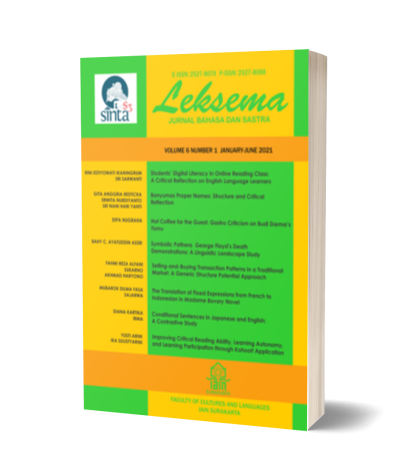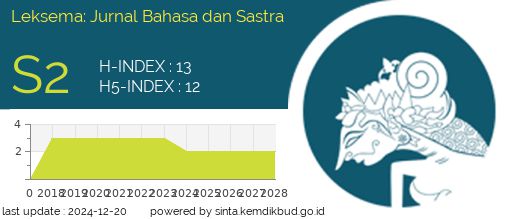THE IDEOLOGY OF POPULAR CULTURE IN ESTI KINASIH’S 'FAIRISH'
DOI:
https://doi.org/10.22515/ljbs.v1i2.201Keywords:
teenager literature, ideology, pop culture, artificial cultureAbstract
This study aims to investigate the ideology of pop culture in Esti Kinasih’s Fairish teenager literature with descriptive analytical method and is framed based on pop culture and ideology theory. The study was conducted by analyzing the representation of pop culture in the intrinsic elements of the novel and in the dialogues and narrations as well. The elements are then analyzed how they are intertwined to form a particular ideology that is injected to the readers. The result of the analysis shows that the novel contains pop culture which is visible from the colloquial language, the partyculture, the dating culture and the stereotypes of boy/girlfriend, and the idea of how to resolve the problem as well. The ideology found is the idea injection that the artificial culture –although it is outside the norm and appropriateness of Indonesian culture- constitutes something that is reasonable and legitimate to do.Downloads
References
Barker, Chris. 2005. Cultural Studies: Teori dan Praktik. Yogyakarta: Bentang Pustaka.
Esti Kinasih. 2005. Fairish [eBook]. Retrieved August 1st 2016, from duniacerita.yu.tl/files/fairish.pdf
Ficky Yusrini. 2016. Fenomena Karin 'Awkarin' Novilda dan 'Generasi Swag', Inilah 7 Alasan Kenapa Para Orang Tua Perlu Cemas. Feature at Femina.co.id.
Kitab Gaul
Moody, Andrew. 2013. “Language Ideology in the Discourse of Popular Culture†in The Encyclopedia of Applied Linguistics - First Edition. UK: Blackwell Publishing.
Nilsen, Alleen Pace and Kenneth L.
Donelson. 2009. Literature for Today’s Young Adults. USA: Pearson.
Rangga Saputra. 2013. Representasi Budaya Populer Dalam Novel Anak B-Jell Cheers Karya Thalia Salsabilla (Tinjauan Sosiologi Sastra). (Unpublished Thesis). Bandung: Universitas Pendidikan Indonesia.
Storey, John. 2008. Cultural Theory and Popular Culture, An Introduction. UK: Pearson.
Strinati, Dominic. 2004. An Introduction to Theories of Popular Culture. London and New York: Routledge.
Urban Dictionary
Downloads
Published
Issue
Section
License
The copyright of the received article shall be assigned to the publisher of the journal. The intended copyright includes the right to publish the article in various forms (including reprints). The journal maintains the publishing rights to published articles.
In line with the license, the authors and users (readers or other researchers) are allowed to share and adapt the material only for non-commercial purposes. In addition, the material must be given appropriate credit, provided with a link to the license, and indicated if changes were made. If authors remix, transform or build upon the material, authors must distribute their contributions under the same license as the original.






